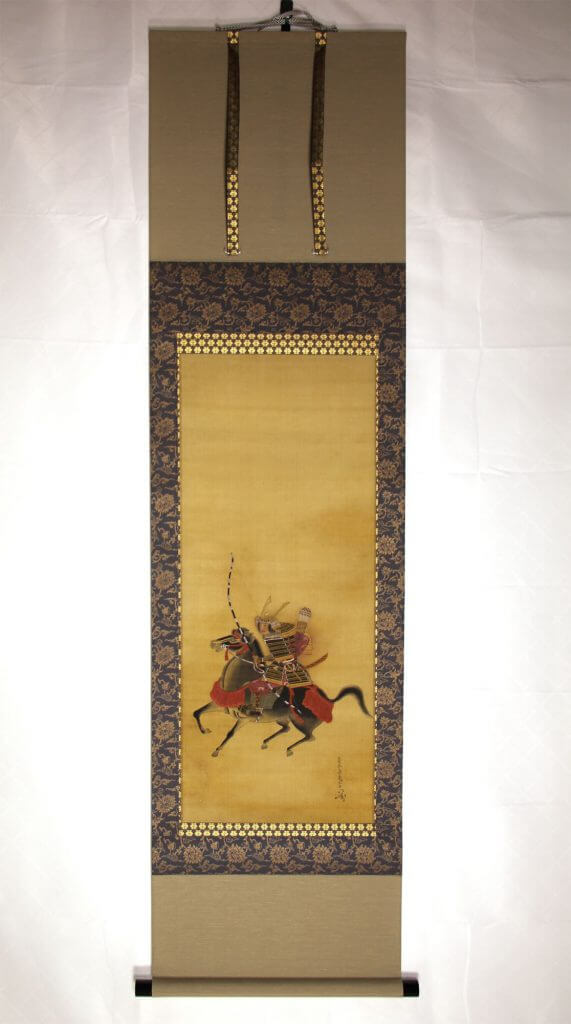Our First International Repeat Order from Europe / Samurai Kakejiku

Contents
- 1 Remounting A Samurai Warrior Scroll
- 2 Suggestions for Mounting Patterns
- 3 The Musha Samurai Warrior Kakejiku Arrived in Kobe, Japan!
- 4 Colour Fixing
- 5 Removing Old Backing Paper
- 6 Urauchi Backing
- 7 Orefuse / Reinforcement
- 8 Hosai / Retouching
- 9 Tsukemawashi, Kiritsugi / Cut and Join
- 10 The second backing
- 11 Tachiawase / Cutting to Size
- 12 Mimi-ori / Folding Over the Edge
- 13 The Final Backing
- 14 Finishing
- 15 Remounting Completed! Here’s a New Hanging Scroll!
- 16 Client’s Voice
- 17 MOVIE
Remounting A Samurai Warrior Scroll
It is not surprising that many of our clients that we have worked together have more than one scroll. Some people are kakejiku scroll enthusiasts. Others love Japanese cultures such as Bonsai, Sado, and flower arrangement. We happen to know this during our conversation. It seems that most of our clients, either Japanese or International, who own more than one scroll, enjoy choosing their next scroll to get it repaired. For some clients, it is going to be tough to focus on just one scroll when everything is important.
Today, with great joy we would like to tell you about our first international repeat order.
Do you remember the “twenty-four generals of Takeda Shingen” scroll?
We kept in touch with the client after the Takeda Shingen scroll was done. We enjoyed talking about scroll maintenance and sometimes we discussed how to repair his other scrolls. Truly, he is a Kakejiku lover who knows a lot about it.
One day in last November, we were asked for pricing and mount samples for his other scroll as follows:
As you know I still have my samurai kakejiku who needs a remounting. This kakejiku is not so important to me like the Takeda kakekjiu who you have done for me, but the condition is bad, and it comes not better in time.
Size overall: 1,65 x 0,44 m
picture only: 0,88 x 0,33 mIn my own opinion, the colour of the silk they used looks not very attractive, possible with the right choice of silk, this kakekjiu looks much better.
Would you give me your sample of a remounting for this kakejiu and a price range as well?
We answered.
From the picture, we think the patterns of an inner enclosure(naka-mawashi) is too large for the size of the samurai warrior. That makes the picture looks busy and are distracting attentions from the samurai warrior. Of course, we are happy to prepare some mounting samples that fit your picture, with the price that is not too expensive.
We wanted to remount this scroll without spending too much money because this scroll was not so important as Takeda Shingen scroll for the client.
Suggestions for Mounting Patterns
For each pattern, we chose chic mount fabrics that have muted colour so that they will bring out the best of the samurai warrior. Also, we selected Gyou-no-gyou mounting style because the artwork was not too long and we knew he liked the traditional Japanese style.
Pattern A
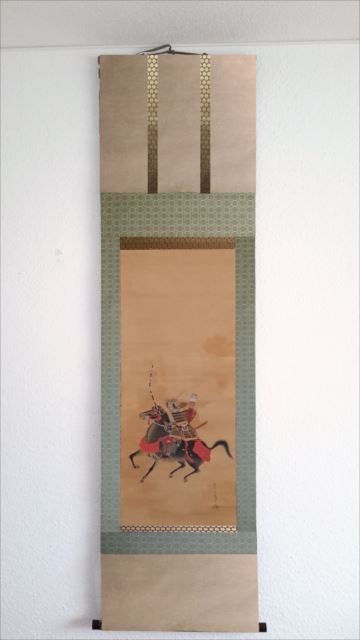
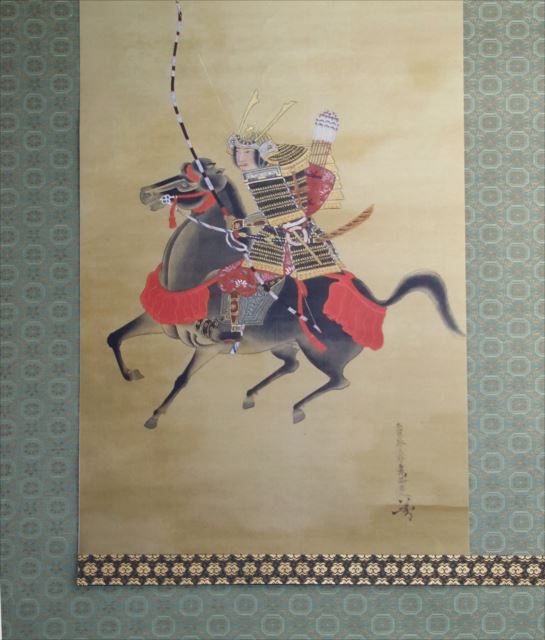
Pattern B
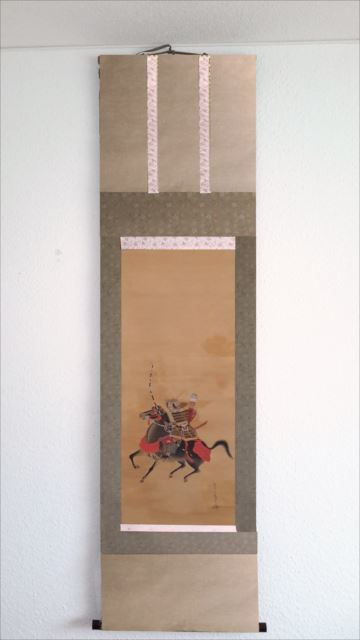
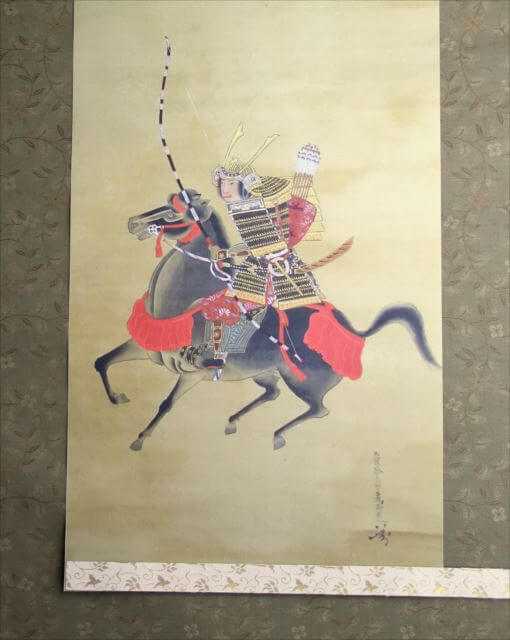
Pattern C
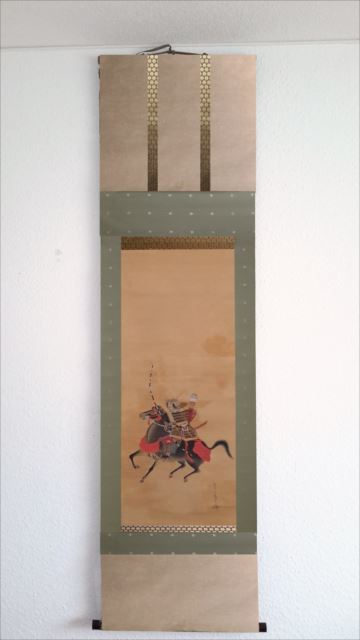
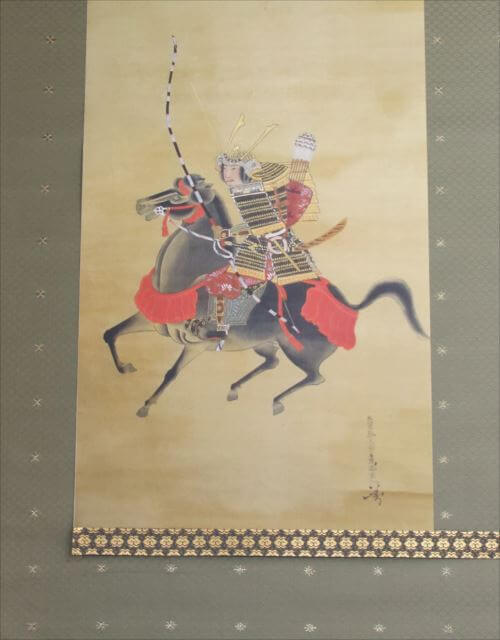
Optional:
+ Ichimonji-otoshi
+ 1 paulownia wood box
The client’s feedback on our first suggestion was that he liked pattern C but the mount fabric colour looked like the Takeda kakejiku. Thus, he would have liked to have another look at other combination. We knew he would ask this! We have always been impressed with how serious he is for finding the best mount pattern for his painting. We prepared two more mount patterns and replied to him asf:
Please do not worry about sharing with us your opinion on mounting samples. We are happy to cater to your needs and requests. We will do our very best to create a kakejiku that is close to your ideal one.
Please see attached file “takeda and Pattern C” for colour comparison. Takeda kakejiku has blue & yellow while Pattern C has muted green. Also attached is our new mounting samples of pattern D & E that will accentuate your picture. Both are the same price as pattern C.

Left: Fabric for Takeda kakejiku
Right: Pattern C
Pattern D
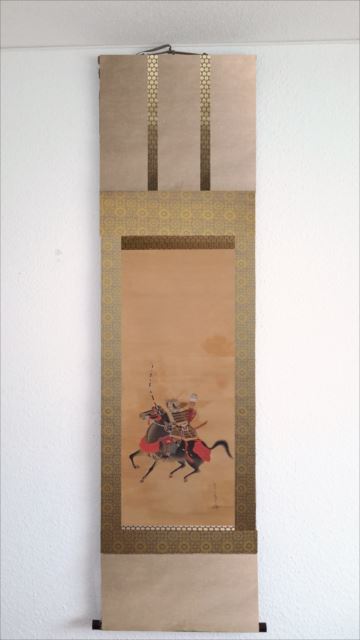
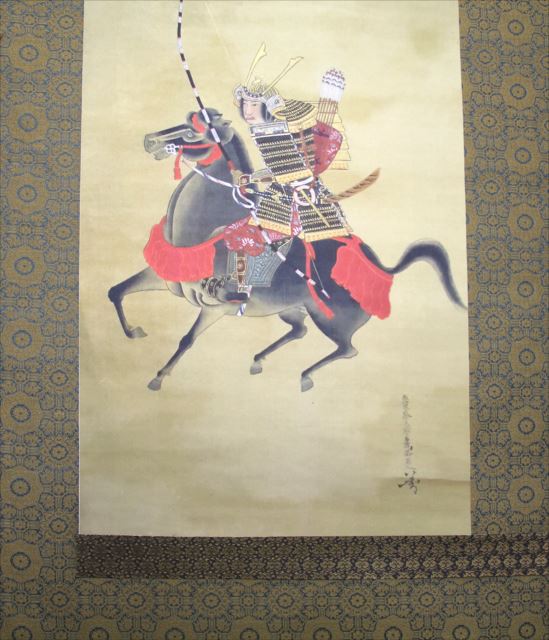
Pattern E
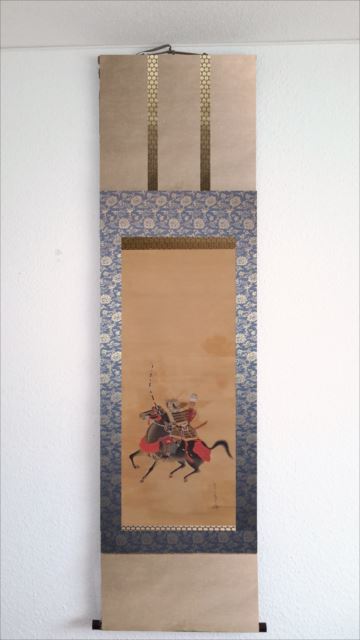
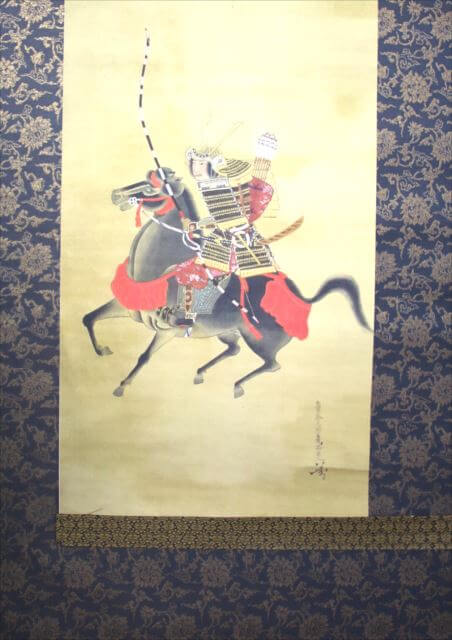
The client liked pattern E and all the details were decided as below;
Remounting for the musha Samurai Warrior kakejiku
+ Mounting Style: Yamato mounting in the manner of ichimonji-otoshi
+ Fabric: No. E
+ Option: 1 paulownia-wood box
+ Lead time: Approx. 3 months after receipt of the payment
+ Inclusive: Shipping charge by EMS (Japan mail post), insurance fee
The Musha Samurai Warrior Kakejiku Arrived in Kobe, Japan!
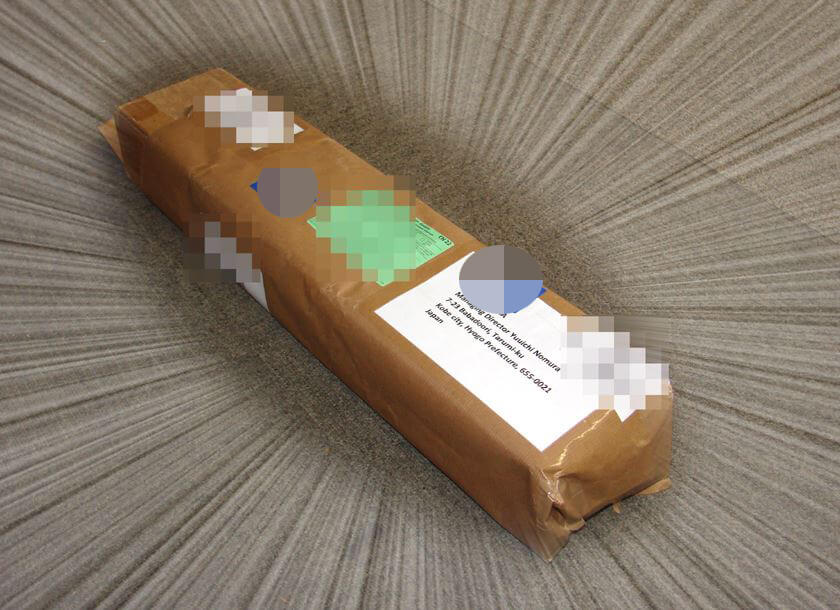
After checking the condition, we did not find any troubles with the scroll so we told the client that the price remained unchanged as our previous estimate. Now the scroll is here in front of us. The client asked us if we see a better combination. We always welcome your ideas and suggestions.
We took another look at the painting, a little deeper this time and took photos of pattern E fabric next to it.

It gives you a different impression from the digital image, doesn’t it?

We honestly thought pattern E looked good on the samurai warrior. Blue inner enclosure(naka-mawashi) brings out the great presence of the Samurai Warrior. Gold in blue naka-mawashi perfectly matches to the gold that is used in the samurai’s armour. A size of the flower patterns is ideal for the painting that they are not too big or do not stand out too much. They have modest beauty.
We reassured the client that we were confident with pattern E and got his reply asf:
Thanks once again for your efforts. Yes, I like them too and I know you have a very good eye to know what is the best for every kakekjiu. That’s so important to me that I have someone to trust because I know you do your very best. I’m happy again to work with you.
Other than mount fabrics, we talked about the finished size and the scroll end knobs.
Everything is decided now. Let’s get to work!
Colour Fixing
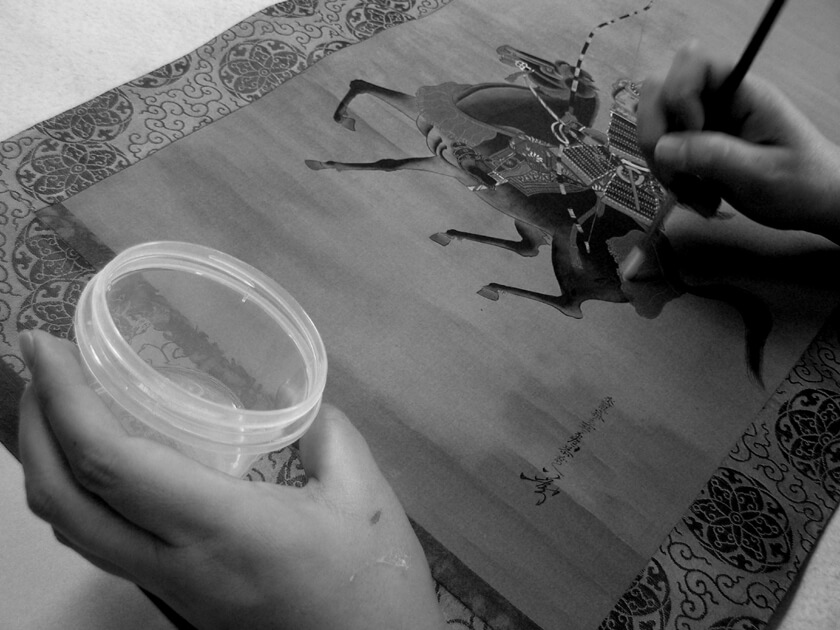
To make our mounting process go more smoothly, we do some prep work if necessary.The red and the green pigments in this artwork is more likely to run than any other colours.

We do colour fixing with special chemical beforehand to prevent colour bleeding. In perfect detail.

Removing Old Backing Paper
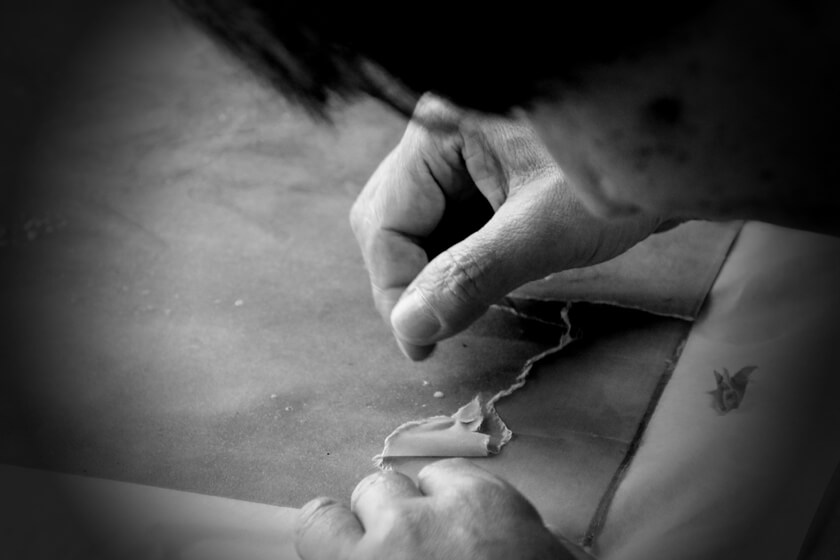
The kakejiku is produced through several urauchi backings. “Urauchi” is the act of applying paper to the back of paper, silk, or fabric with paste for reinforcement.
The first step in remounting kakejiku is to remove the old backing paper carefully.
Generally, there are three layers of backing paper. They are applied in the order of “hada ura-uchi”(the first), “mashi urauchi”(the second), “sou urauchi”(the final) from the back of a “honshi” main artwork. When removing the paper, we start working on with outside, “sou urauchi”(the final) in reverse order.
When it comes to degree of difficulty, the closer to a main work, the harder it becomes. Therefore, removing “hada ura-uchi”(the first backing) is the most difficult since it is directly applied to a main artwork. It is also regarded as the most difficult step in the whole repair procedure.
We focused all our attention to these points because we were afraid of these damaged parts of the painting would come off together with the backing paper. If we peel the paper back at once, it may result in further damage in case the former conservator had used strong paste. Thus, we peeled the backing paper slowly and carefully, pressing the painting gently with a tapered awl in order to prevent it from coming off.



Urauchi Backing
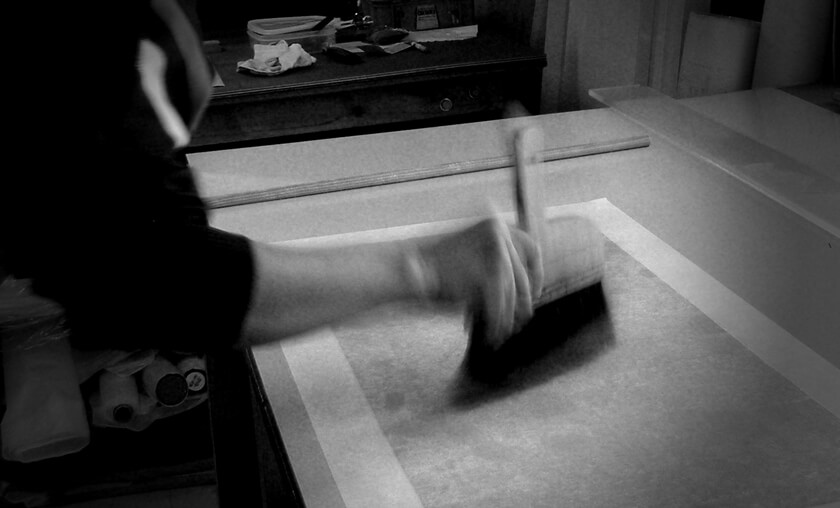
We simply start applying water to the painting face-down to prepare it for mounting. The thing to remember is that you should not get it too wet. So, we use a spray bottle to wet it with a fine mist.

We take our hands and in the middle press down while pushing to the sides. What we are doing here is stretching the painting and keep it straight. A straightedge is put next to it for assistance.

After removing old backings, Oh! we found some flakings and tears in the bottom as shown below.

We did not notice until we removed backings because the damage was almost invisible. This means that the painting had been remounted before. Very well mended by a skilful conservator. We assume that they have pulled crackings to fill the gap and applied backing paper that looked closer to the ground colour of the painting. We told the client about the damage and our future actions. That was to apply “ore-fuse” for reinforcement and “retouching-hosai” to the lacking parts.
The closer to the fragile parts the more careful and patient we need to be to prevent the distortion. Here, we are covering the simple tears by pulling the silk as natural as possible.

This is the preparation of the first backing paper before applying paste to it.

Evenly apply paste to a brand-new 1st backing paper. Too little paste will make the backing paper peel off. Too much paste makes the whole scroll stiff. Finding the perfect balance between them requires a craftsman’s extensive knowledge and experience.
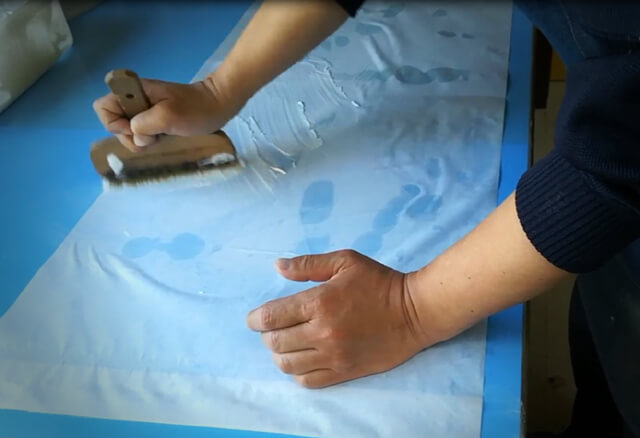
Brush against the first backing paper. Keep a consistent rhythm until you reach the other side.

After attaching the backing paper, its surface is tapped with the brush for adhering the backing paper firmly to the main work. Keep tapping until they adhere to each other completely.

Take the painting from the table and put it on the “karibari” board, then let it dry for a while.

Orefuse / Reinforcement

The painting had some creases and wrinkles. These areas are very brittle so they need to be reinforced in order to prevent future damage. We repaired in a traditional way called ”ore-fuse”, which is to apply thin Japanese paper to the wrinkles from the back of the first (skin) backing paper.
Hosai / Retouching

Retouching is a restoration process to re-establish colour and detail to losses in the painting. We carry out only to areas of paint loss, being careful not to ruin the original painting.

Tsukemawashi, Kiritsugi / Cut and Join

After completing retouching, the artwork is cut into a square where each corner is a right angle. Otherwise, once it is finished in a hanging scroll, it looks crooked when you step back and look at it.

Preparing the fabric of the inner enclosure.

Cutting the fabric of Ichimonji.


A set of mount fabrics.
Always start with “noridome” to fabrics. Apply paste along the raw edges to prevent them from fraying.

Apply a “ichimonji-otoshi / falling ichimonji” from the back.

You can see “ore-fuse” are applied at the bottom.

Apply top(kami) and bottom(shimo) ichimonji.

Move on to the pillars of the inner enclosure.

Apply paste to the edge of the bottom inner enclosure.

Put it on.

Apply top/ten.

After applying all fabrics, we slide a tapered awl up and down against where the fabric pieces meet/overlapped. This is to confirm whether the paste has set or not.

Turn over the scroll sheet and do the same.

The second backing
The second backing is called “mashi-urauchi”. (subsidiary backing of the main work and mounting fabric.) Mashi-urauchi is for adjusting strength between artwork and mounting fabrics. For thin, less tensile scroll, we use a firmer, thicker paper. For a high tensile scroll, we use a thinner paper. A fluid scroll can be achieved by adjusting balance and make it easy to unroll and roll up.
Tachiawase / Cutting to Size

After the second backing, take the artwork from the kari-bari board and cut it into a required size.

Tools for tachiawase.
Place a bamboo ruler on the scroll.

Make a mark on the top and bottom each with an awl.

Turn over the scroll sheet. Place a straightedge along the marks. Use it as a guide and mark the line with the awl to create a sharp crease.

Next, take a utility knife and cut the scroll with a straightedge.

This utility knife is designed to cut materials into approx. 3mm width that makes perfect folding flaps for “mimi-ori”. See below.

Mimi-ori / Folding Over the Edge

An act of folding flaps over the edges (by 3mm fixed width) is called “Mimi-ori” that has two effects as follows:
+ helps to stop the fabric from fraying.
+ makes the pillar ends thicker and strong.
Fold the flaps inwards along the crease line.

Apply paste to the flaps.

And press.

The Final Backing
An act of applying the last backing paper is called “sou-ura-uchi”. This will be done to adjust the balance of the hanging scroll.
Finishing

We are finally assembling the scroll, using a hanging rod at the top, and a roller rod on the bottom of the paper.
After applying paste to secure the hanging rod to the edges of the paper, press firmly and hold for a few seconds to ensure the rod is adequately attached to the paper.

Attach ring tacks to the rod.

Sew decorative strips (fuutai) on to the rod.

Tie a hanging cord (kakeo) to the ring tacks tightly.

Let us go on to the roller rod on the bottom. Wrap the fabric around the rod firmly.

When rolling, put in a sheet of paper to avoid paste stain. It looks like we are making a sushi roll.

Now, we are really done.

Remounting Completed! Here’s a New Hanging Scroll!
The blue inner enclosure(naka-mawashi) has a premium look. The colour of blue is deep but has a shiny lustre which makes them conspicuous even from a distance. Well-matched mount fabrics can make all the difference to a scrolls’ look. They can stand out and define the painting. With this painting, the Samurai Warrior appears brighter and livelier. It looks much better in person than in photos. We wish you could come and see this! All our staff gave a happy sigh when they saw the finished kakejiku like, “Oh, it’s beautiful”.
The lacking parts and creases became unnoticeable by retouching. It required assiduity and eagerness to achieve the best possible result.
Client’s Voice

Lastly, we would like to show you the amazing photos of the scroll, courtesy of the client.

The kakejiku has already arrived at my home and I’m very excited with your work. The fabrics match very well together and the samurai warrior comes out much better than before. Especially the Naka-mawashi together with the kami-ichimonji fabric gives the whole picture a very attractive look.
Many old or antique kakekjiu’s where are not mounted with such nice fabrics, mostly they are mounted very simply. To me, the art of mounting for a kakejiku is very much important and I have to say thank you one more for your help in choosing the right fabric.
I see now the retouching-hosai and the parts where the silk was broken after removing the old backing paper. But both work is done with much care and highly skills by your craftsmen.
I really want to say my huge thanks to you and your craftsmanship with all my heart.
We received more comments. We were so moved by this because it was like a beautiful poem:
“I just stand up, it`s Saturday morning now, I walk in the living room where the samurai kakejiku decorates the wall.
And I can`t say how much I like them. Sorry it is just my feelings about the whole picture I have for now. It looks so good in my opinion, I never imagine this, before and after a remounting process can look the same picture so much better than before.”
We are lucky to receive such kind comments from the client. This is really motivating for all our team. It has been great working with you one more time, and we hope to work with you again in the future. Thank you very much for your repeat order.
MOVIE




